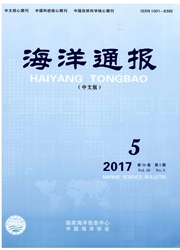

 中文摘要:
中文摘要:
基于该系列文章前文建立的高分辨率数据同化模型系统,研究渤、黄海的M2分潮的潮汐特征、潮混合、潮余流、潮能及其扩散、潮动量平衡。对同潮图结果的分析表明,渤、黄海内共存在4个无潮点,研究区域内M2分潮振幅的最大值出现在朝鲜半岛西侧。潮流椭圆的分析结果表明,在35°N附近区域潮流椭圆的旋转方向有着比较突然的改变。朝鲜半岛西侧区域潮流的振幅较大,并且由于该区域地形复杂多变导致朝鲜半岛西侧海域存在着比较强烈的潮混合与潮耗散。对M2分潮动量分析的结果表明,地形等因素在近海潮汐动力学过程中发挥着比较重要的作用。在渤、黄海内大部分区域,主要的动量平衡基本上介于压强梯度力、局地变化项以及科氏力之间,底应力和对流项都可以忽略不计。但是,线性模型对近海尤其是上述强耗散区内潮波活动的模拟还是存在着缺陷和不足。
 英文摘要:
英文摘要:
A high-resolution hybrid data assimilative(DA) modeling system is adopted to study on tidal characteristics,tidal mixing, residual currents, energy flux, dissipation and momentum term balance dynamics in the Bohai and Yellow Seas.Our solutions show together there are four amphidromic points in the Bohai and Yellow Seas. Significantly larger tidal ranges are found along the west coast of Korea Peninsula. Tidal current ellipse maps reveal an abrupt change in tidal rotation directions in the Yellow Sea around 35 °N, and currents are the strongest along the west coast of Korea Peninsula, which are combined with rough and irregular bottom bathymetry, producing significant tidal mixing and energy dissipation. Momentum balance analyses on M2 further confirm the complexity of tidal dynamics in this area. For most regions in our study area, the main dynamical balance is among the pressure gradient, local acceleration terms, and Coriolis force, and bottom friction and horizontal advection are smaller. But a simple linear, analytical model will not adequately reproduce tidal currents and elevations.
 同期刊论文项目
同期刊论文项目
 同项目期刊论文
同项目期刊论文
 Impact of Preceding El Nino and the Indian Ocean Dipole on the Southern China Precipitation in Early
Impact of Preceding El Nino and the Indian Ocean Dipole on the Southern China Precipitation in Early 期刊信息
期刊信息
